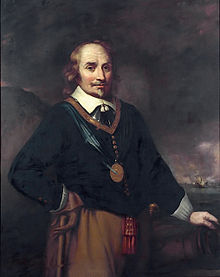Dutch admiral. While at sea with his father on a Vereenigde Oostindische Compaagnie (VOC) ship to India, he was taken prisoner by an English pirate and made to serve as a cabin boy for two years. He saw his first naval action in 1617 against the Barbary corsairs. He signed on to a Dutch armed merchantman two years later, and was captured by pirates a second time in 1621. In 1624, he took command of a Dutch frigate in the war against Spain. Within five years, he rose to captain of the admiral’s flagship. He rose to admiral himself by the mid-1630s, after overcoming personal and political rivalries.
Over the rest of his career, Tromp emerged as one of the premier sea captains in any Navy during the 17th century. In 1639, he carried out a raid against Dunkirk pirates and privateers. That same year he led a squadron of 18 Dutch sail to victory over a huge Spanish invasion fleet off The Downs, capturing 13 galleons and 57 other prizes out of a convoy of 100 ships. It was an astonishing, decisive, crushing victory that helped decide the outcome of the Eighty Years’ War (1568-1648). In 1646, Tromp aided an attack on the privateer base at Dunkirk. He exchanged fire with Robert Blake off Dover on May 19/29, 1652, in defiance of the English claim to “sovereignty of the sea.” That action led directly to the First Anglo-Dutch War (1652-1654).
Tromp lost half his fleet to a gale in July 1652, and was sacked upon his return to the Netherlands. He was restored after the disaster, for the Dutch suffered in his absence at Kentish Knock (September 28/October 8, 1652). He fought Blake twice in the Channel, driving him up the Thames at Dungeness (November 30/ December 10, 1652). He again fought Blake, but inconclusively, in a three-day battle off Portland (February 18-20/February 28-March 2, 1653). Tromp fought next at Gabbard Shoal (June 2-3/12-13, 1653). He and the Dutch Navy failed to adjust to the new English tactic of line of battle, as ordered in the fighting instructions. As a result, Tromp led and lost badly at Texel (July 31/August 10, 1653), where he was killed by a musket ball.
Battle of Portland, (February 18-20/February 28-March 2, 1653)
“Three Days’ Battle.” A sea fight of the First Anglo-Dutch War (1652-1654).Maarten van Tromp, with 75 warships, was escorting a Dutch convoy of 150 merchantmen up the Channel when he was met off Portland by Robert Blake. The latter was lying in wait with a picket line of ships from Portland to the Cotentin peninsula, but he had neglected to post any scouts. Accordingly, Tromp struck as soon as he came upon one end of the English line, attacking an exposed wing before the rest of Blake’s fleet could close. Poor Dutch gunnery and still poorer discipline allowed the rest of Blake’s ships to beat close toward the end of the first day. The next morning, superior English broadside gunnery inflicted serious damage on the Dutch, but the skillful Tromp re-formed his escorts into a defensive shield at the rear of the convoy and fought well as he retreated up the Channel. During the third day, English frigates broke in among the merchantmen and began to take prizes, like wolves cutting individual sheep from a flock. Dutch escorts began to lose heart, even as they also ran low on powder and shot. Many ships were pressed hard against the French coast to await surrender at dawn of the fourth day. Instead, Tromp brilliantly escaped on the tide and was gone before the English noticed. Over three days, the Dutch had lost nine warships and 24 merchantmen, but the English had again failed to close a trap that had been improperly set.
